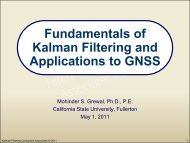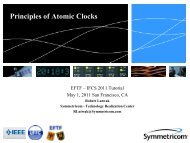MEMS Resonators for Frequency Control and Sensing Applications
MEMS Resonators for Frequency Control and Sensing Applications
MEMS Resonators for Frequency Control and Sensing Applications
You also want an ePaper? Increase the reach of your titles
YUMPU automatically turns print PDFs into web optimized ePapers that Google loves.
Principle of Operation<br />
Admittance<br />
<strong>Frequency</strong><br />
• Key quantities that define a sensor per<strong>for</strong>mance:<br />
• Addition of mass onto the<br />
resonator affects its<br />
acoustic characteristics.<br />
• <strong>Frequency</strong> is generally<br />
monitored, but other<br />
variables such as phase<br />
<strong>and</strong> magnitude could also<br />
be measured<br />
– Sensitivity (amount of change in measured variable <strong>for</strong> change in measur<strong>and</strong>);<br />
depends on both transducer characteristics as well as chemically adsorbing<br />
layer<br />
– Limit of detection (LOD= minimum detectable change in the measur<strong>and</strong>)<br />
– Speed of detection (b<strong>and</strong>width required <strong>for</strong> accurate measurement; could<br />
ultimately be limited by the adsorbing layer & kinetics of reaction)<br />
– Selectivity (ability to distinguish one species from another: depends on the<br />
adsorbing layer <strong>and</strong> not the transducer)




